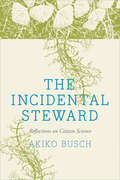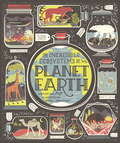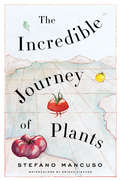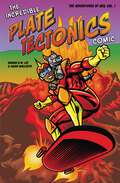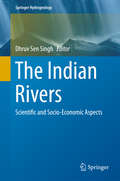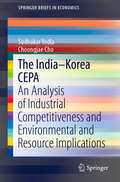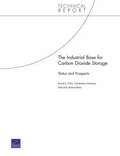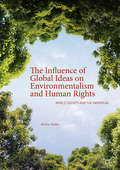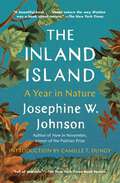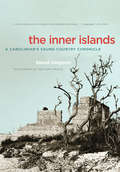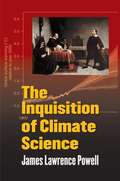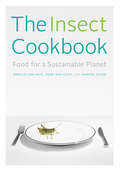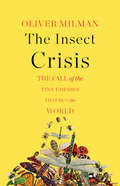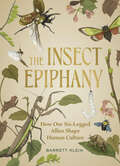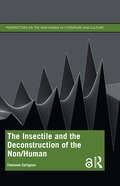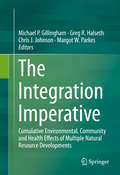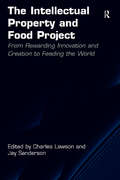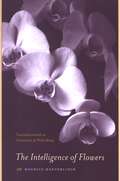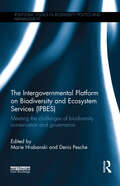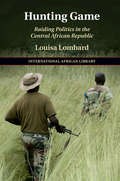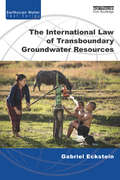- Table View
- List View
The Incidental Steward: Reflections on Citizen Science
by Akiko BuschA search for a radio-tagged Indiana bat roosting in the woods behind her house in New York's Hudson Valley led Akiko Busch to assorted other encounters with the natural world--local ecological monitoring projects, community-organized cleanup efforts, and data-driven citizen science research. Whether it is pulling up water chestnuts in the Hudson River, measuring beds of submerged aquatic vegetation, or searching out vernal pools, all are efforts that illuminate the role of ordinary citizens as stewards of place. In this elegantly written book, Busch highlights factors that distinguish twenty-first-century citizen scientists from traditional amateur naturalists: a greater sense of urgency, helpful new technologies, and the expanded possibilities of crowdsourcing. The observations here look both to precisely recorded data sheets and to the impressionistic marginalia, scribbled asides, and side roads that often attend such unpredictable outings. While not a primer on the prescribed protocols of citizen science, the book combines vivid natural history, a deep sense of place, and reflection about our changing world. Musing on the expanding potential of citizen science, the author celebrates today's renewed volunteerism and the opportunities it offers for regaining a deep sense of connection to place.
The Incredible Ecosystems of Planet Earth
by Rachel IgnotofskyAn illustrated tour of our planet's ecosystems both large and small, from reefs, deserts and rainforests to a single drop of water - from the bestselling author of Women in Science. Through exquisite illustrations, maps and infographics, bestselling author Rachel Ignotofsky explains how our planet works, from its incredible ecosystems and the plants and animals that live there to the importance of biodiversity, weather cycles and more. Including information on the dangers of climate change and ideas for how to protect Planet Earth, this utterly charming guide is the perfect gift for all nature-loving readers on the planet we call home.
The Incredible Journey of Plants
by Stefano MancusoIn this richly illustrated volume, a leading neurobiologist presents fascinating stories of plant migration that reveal unexpected connections between nature and culture.When we talk about migrations, we should study plants to understand that these phenomena are unstoppable. In the many different ways plants move, we can see the incessant action and drive to spread life that has led plants to colonize every possible environment on earth. The history of this relentless expansion is unknown to most people, but we can begin our exploration with these surprising tales, engagingly told by Stefano Mancuso. Generation after generation, using spores, seeds, or any other means available, plants move in the world to conquer new spaces. They release huge quantities of spores that can be transported thousands of miles. The number and variety of tools through which seeds spread is astonishing: we have seeds dispersed by wind, by rolling on the ground, by animals, by water, or by a simple fall from the plant, which can happen thanks to propulsive mechanisms, the swaying of the mother plant, the drying of the fruit, and much more. In this accessible, absorbing overview, Mancuso considers how plants convince animals to transport them around the world, and how some plants need particular animals to spread; how they have been able to grow in places so inaccessible and inhospitable as to remain isolated; how they resisted the atomic bomb and the Chernobyl disaster; how they are able to bring life to sterile islands; how they can travel through the ages, as they sail around the world.
The Incredible Plate Tectonics Comic: The Adventures of Geo, Vol. 1
by Adam Wallenta Kanani K. LeeThe Incredible Plate Tectonics Comic is a wild adventure in earth science. Follow Geo and his robot dog, Rocky, as they travel back in time to Pangea, surf a tsunami, and escape an erupting volcano—all in time for Geo’s first-period science test!The journey starts 200 million years ago and takes you to modern-day Hawai’i, the ocean floor, and deep inside the Earth.You’ll learn:–How scientists developed the theory of plate tectonics–Why the Earth shakes–What’s in the center of the Earth–How volcanoes can form islandsThe Incredible Plate Tectonics Comic will teach you about geology in a fun, lively, and visual way.Ages 8+. Recommended for grade 6 and up
The Indian Rivers: Scientific and Socio-economic Aspects (Springer Hydrogeology)
by Dhruv Sen SinghThe book presents geomorphological studies of the major river basins - the Indus, Ganga and Brahmaputra and their tributaries. Besides major basins, the book explores peninsular rivers and other rivers state-by-state. All types of rivers, i. e. snow-fed, rain-fed and groundwater-fed rivers are explained together in geological framework. Rivers are lifeline and understanding of the rivers, their dynamics, science and socio-economic aspect is very important. However, different sources provide different data base for rivers. But a book which explains all major rivers of a country at a single place was not yet available. This book is the first book of its kind in the world which provides expert opinion on all major rivers of a country like India. This book complements works in these areas for the last two to three decades on major rivers of India by eminent professors and scientists from different universities, IITs and Indian research institutions. The information presented in the book would appeal to a wider readership from students, teachers to researchers and planners engaged in developmental work and also to common people of the society concerned with awareness about rivers.
The India–Korea CEPA: An Analysis of Industrial Competitiveness and Environmental and Resource Implications (SpringerBriefs in Economics)
by Sudhakar Yedla Choongjae ChoThis book assesses the changes that the Comprehensive Economic Partnership Agreement (CEPA) could produce by boosting the competitiveness of firms in India and Korea. It evaluates the CEPA in terms of its effects on the environment and natural resources of the importing and exporting countries alike. Further, it employs the revealed comparative advantage (RCA) and relative trade advantage (RTA) methods of analysis to gauge the influence of the CEPA on industrial competitiveness in both host and receiving countries. While the CEPA would increase trade between India and Korea in their respective strong domains, the book argues that, given the nature of the exported and imported goods and products, India would be more susceptible to serious environmental impacts than would Korea. The book subsequently presents these impacts in a qualitative framework and stresses the need for a comprehensive valuation of not only environmental impacts, but also the losses due to tariff cuts and the gains due to increased trade between the two countries.
The Industrial Base for Carbon Dioxide Storage: Status and Prospects
by David S. Ortiz Constantine Samaras Edmundo Molina-PerezIf policies aimed at large reductions of carbon dioxide (CO2) emissions are enacted, more carbon capture and storage will be needed. RAND researchers explored the ability of the industrial base supporting the transportation and sequestration of CO2 to expand, assessing the industrial base for transportation and injection of CO2 for both geologic storage and enhanced oil recovery.
The Influence of Global Ideas on Environmentalism and Human Rights
by Markus HadlerThis book explores whether individual attitudes and behaviors are swayed by global developments in a world increasingly populated by organizations, treaties, and other institutions that focus on environmentalism and human rights. It uses the sociological approach of World Society theory to investigate the effects of global ideas on individual environmentalism, xenophobia, and homophobia while drawing its data from a variety of international public opinion surveys. The Influence of Global Ideas on Environmentalism and Human Rights questions the dominant narrative of World Society related research as a positive influence of global ideas on various outcomes. Hadler demonstrates the complexity of this issue through empirical analyses revealing mixed trends in attitudes and behaviors from around the world. This book will be of interest to academics seeking to critically engage with World Society theory through two of its core topics: human rights and environmentalism.
The Inland Island: A Year in Nature
by Josephine Johnson&“A beautiful book...about nature the way Walden was a book about nature. It should be read by everyone who still retains the capacity to feel anything&” (The New York Times). Stunningly written and fiercely observed, a new edition of a classic work of nature writing about a year on an Ohio farm, by Pulitzer Prize–winning author Josephine Johnson.Originally published in 1969, The Inland Island is Josephine W. Johnson&’s startling and brilliant chronicle of nature and the seasons at her rambling thirty-seven-acre farm in Ohio, which she and her husband reverted to wilderness with the help of a state forester. Over the course of twelve months, she observes the changing landscape with a naturalist&’s precision and a poet&’s evocative language. Readers will marvel at the way she brings to life flashes of beauty, the inexorable cycle of growth and decay, and the creatures who live alongside her, great and small. A forerunner of iconic American women nature writers and a champion of civil rights who marched in Washington against the Vietnam war, Johnson intersperses these &“delicate marvels&” (The New York Times) with profound reflections about racial inequality, urbanization, social justice, and environmental destruction that speak powerfully to our time. Ready to be rediscovered by a new generation, The Inland Island is a vital and relevant meditation on nature and time, capturing the wonder, beauty, hope—and flaws—of our turbulent world.
The Inner Coast: Essays
by Donovan HohnPrize-winning essays on our changing place in the natural world by the best-selling author of Moby-Duck. Writing in the grand American tradition of Annie Dillard and Barry Lopez, Donovan Hohn is an “adventurous, inquisitive, and brightly illuminating writer” (New York Times). Since the publication of Moby-Duck a decade ago, Hohn has been widely hailed for his prize-winning essays on the borderlands between the natural and the human. The Inner Coast collects ten of his best, many of them originally published in such magazines as the New York Times Magazine and Harper’s, which feature his physical, historical, and emotional journeys through the American landscape. By turns meditative and comic, adventurous and metaphysical, Hohn writes about the appeal of old tools, the dance between ecology and engineering, the lost art of ice canoeing, and Americans’ complicated love/hate relationship with Thoreau. The Inner Coast marks the return of one of our finest young writers and a stylish exploration of what Guy Davenport called “the geography of the imagination.”
The Inner Islands
by Bland Simpson Ann Cary SimpsonBlending history, oral history, autobiography, and travel narrative, Bland Simpson explores the islands that lie in the sounds, rivers, and swamps of North Carolina's inner coast. In each of the fifteen chapters in the book, Simpson covers a single island or group of islands, many of which, were it not for the buffering Outer Banks, would be lost to the ebbs and flows of the Atlantic. Instead they are home to unique plant and animal species and well-established hardwood forests, and many retain vestiges of an earlier human history.
The Inquisition of Climate Science
by James Lawrence PowellScience is under the greatest and most successful attack in modern history. An industry of denial, abetted by media more interested in selling controversy than presenting facts, has duped half the American public into rejecting the facts of climate science--facts showing that human-caused emissions are warming the Earth. The industry of climate science denial is succeeding: public acceptance has declined even as the scientific evidence for global warming has increased. It is vital that the public understand how anti-science ideologues, pseudoscientists, and non-scientists have bamboozled them. We cannot afford to get global warming wrong, yet thanks to deniers and their methods, we are.Jim Powell's The Inquisition of Climate Science is the first book to take on comprehensively the climate science denial movement and the deniers themselves, exposing their lack of credentials, industry funding, and absence of any alternative theory to explain the observed evidence of warming. In this book, readers meet the most prominent deniers and participate in a dissection of their credentials, arguments, and lack of objectivity. James Lawrence Powell shows that the deniers use a wide variety of deceptive rhetorical techniques, many of them going back to the Greeks. While written for the general reader and non-scientist, this book is carefully researched and fully referenced. Readers with an open mind will learn that the evidence of global warming is real and see that an industry of denial has deceived the American public, putting them and their grandchildren at risk.
The Inquisition of Climate Science
by James PowellModern science is under the greatest and most successful attack in recent history. An industry of denial, abetted by news media and "info-tainment" broadcasters more interested in selling controversy than presenting facts, has duped half the American public into rejecting the facts of climate science—an overwhelming body of rigorously vetted scientific evidence showing that human-caused, carbon-based emissions are linked to warming the Earth. The industry of climate science denial is succeeding: public acceptance has declined even as the scientific evidence for global warming has increased. It is vital that the public understand how anti-science ideologues, pseudo-scientists, and non-scientists have bamboozled them. We cannot afford to get global warming wrong—yet we are, thanks to deniers and their methods.The Inquisition of Climate Science is the first book to comprehensively take on the climate science denial movement and the deniers themselves, exposing their lack of credentials, their extensive industry funding, and their failure to provide any alternative theory to explain the observed evidence of warming. In this book, readers meet the most prominent deniers while dissecting their credentials, arguments, and lack of objectivity. James Lawrence Powell shows that the deniers use a wide variety of deceptive rhetorical techniques, many stretching back to ancient Greece. Carefully researched, fully referenced, and compellingly written, his book clearly reveals that the evidence of global warming is real and that an industry of denial has deceived the American public, putting them and their grandchildren at risk.
The Insect Cookbook
by Marcel Dicke Françoise Takken-Kaminker Arnold Van Huis Henk Van Gurp Diane Blumenfeld-SchaapInsects will be appearing on our store shelves, menus, and plates within the decade. In The Insect Cookbook, two entomologists and a chef make the case for insects as a sustainable source of protein for humans and a necessary part of our future diet. They provide consumers and chefs with the essential facts about insects for culinary use, with recipes simple enough to make at home yet boasting the international flair of the world's most chic dishes.Insects are delicious and healthy. A large proportion of the world's population eats them as a delicacy. In Mexico, roasted ants are considered a treat, and the Japanese adore wasps. Insects not only are a tasty and versatile ingredient in the kitchen, but also are full of protein. Furthermore, insect farming is much more sustainable than meat production. The Insect Cookbook contains delicious recipes; interviews with top chefs, insect farmers, political figures, and nutrition experts (including chef René Redzepi, whose establishment was elected three times as "best restaurant of the world"; Kofi Annan, former secretary-general of the United Nations; and Daniella Martin of Girl Meets Bug); and all you want to know about cooking with insects, teaching twenty-first-century consumers where to buy insects, which ones are edible, and how to store and prepare them at home and in commercial spaces.
The Insect Cookbook: Food for a Sustainable Planet (Arts and Traditions of the Table: Perspectives on Culinary History)
by Marcel Dicke Arnold van Huis Henk van GurpThe Definitive Guide to Insects as a Sustainable Food SourceIn The Insect Cookbook, two entomologists and a chef make the case for insects as a sustainable source of protein for humans and a necessary part of our future diet. They provide consumers and chefs with the essential facts about insects for culinary use, with recipes simple enough to make at home yet boasting the international flair of the world's most chic dishes."Invite politicians to dinner and let them tell the world how delicious it is.... They will proudly go around and say, 'I ate crickets, I ate locusts, and they were delicious.'"—Kofi Annan The Insect Cookbook features delicious recipes and interviews with top chefs, insect farmers, political figures, and nutrition experts, including chef René Redzepi, whose establishment was elected three times as "best restaurant of the world"; Kofi Annan, former secretary-general of the United Nations; and Daniella Martin of Girl Meets Bug. The book contains all you need to know about cooking with insects, where to buy them, which ones are edible, and how to store and prepare them at home and in commercial spaces.
The Insect Crisis: The Fall of the Tiny Empires That Run the World
by Oliver MilmanA devastating examination of how collapsing insect populations worldwide threaten everything from wild birds to the food on our plate. From ants scurrying under leaf litter to bees able to fly higher than Mount Kilimanjaro, insects are everywhere. Three out of every four of our planet’s known animal species are insects. In The Insect Crisis, acclaimed journalist Oliver Milman dives into the torrent of recent evidence that suggests this kaleidoscopic group of creatures is suffering the greatest existential crisis in its remarkable 400-million-year history. What is causing the collapse of the insect world? Why does this alarming decline pose such a threat to us? And what can be done to stem the loss of the miniature empires that hold aloft life as we know it? With urgency and great clarity, Milman explores this hidden emergency, arguing that its consequences could even rival climate change. He joins the scientists tracking the decline of insect populations across the globe, including the soaring mountains of Mexico that host an epic, yet dwindling, migration of monarch butterflies; the verdant countryside of England that has been emptied of insect life; the gargantuan fields of U.S. agriculture that have proved a killing ground for bees; and an offbeat experiment in Denmark that shows there aren’t that many bugs splattering into your car windshield these days. These losses not only further tear at the tapestry of life on our degraded planet; they imperil everything we hold dear, from the food on our supermarket shelves to the medicines in our cabinets to the riot of nature that thrills and enlivens us. Even insects we may dread, including the hated cockroach, or the stinging wasp, play crucial ecological roles, and their decline would profoundly shape our own story. By connecting butterfly and bee, moth and beetle from across the globe, the full scope of loss renders a portrait of a crisis that threatens to upend the workings of our collective history. Part warning, part celebration of the incredible variety of insects, The Insect Crisis is a wake-up call for us all.
The Insect Epiphany: How Our Six-Legged Allies Shape Human Culture
by Barrett KleinFrom entomologist Barrett Klein comes a buzz-worthy exploration of the many ways insects have affected human society, history, and culture Insects surround us. They fuel life on Earth through their roles as pollinators, predators, and prey, but rarely do we consider the outsize influence they have had on our culture and civilization. Their anatomy and habits inform how we live, work, create art, and innovate. Featuring nearly 250 color images—from ancient etchings to avant-garde art, from bug-based meals to haute couture—The Insect Epiphany proves that our world would look very different without insects, not just because they are crucial to our ecosystems, but because they have shaped and inspired so many aspects of what makes us human.
The Insectile and the Deconstruction of the Non/Human (Perspectives on the Non-Human in Literature and Culture)
by Fabienne CollignonThe Insectile and the Deconstruction of the Non/Human defines, conceptualizes, and evaluates the insectile—pertaining to an entomological fascination—in relation to subject formation. The book is driven by a central dynamic between form and formlessness, further staging an investigation of the phenomenon of fascination using Lacanian psychoanalysis, suggesting that the psychodrama of subject formation plays itself out entomologically. The book’s engagement with the insectile—its enactments, cultural dreamwork, fantasy transformations—‘in-forming’ the so-called human subject undertakes a broader deconstruction of said subject and demonstrates the foundational but occluded role of the insectile in subject formation. It tracks the insectile across the archives of psychoanalysis, seventeenth century still life painting, novels from the nineteenth century to the present day, and post-1970s film. The Insectile and the Deconstruction of the Non/Human will be of interest for scholars, graduate students, and upper-level undergraduates in film studies, visual culture, popular culture, cultural and literary studies, comparative literature, and critical theory, offering the insectile as new category for theoretical thought.
The Integration Imperative
by Chris J. Johnson Margot W. Parkes Michael P. Gillingham Greg R. HalsethThe purpose of this work is to develop a better understanding and thinking about the cumulative impacts of multiple natural resource development projects. Cumulative impacts are now one of the most pressing, but complex challenges facing governments, industry, communities, and conservation and natural resource professionals. There has been technical and policy research exploring how cumulative environmental impacts can be assessed and managed. These studies, however, have failed to consider the necessary integration of community, environment and health. Informed by knowledge and experience in northern British Columbia, this book seeks to expand our understanding of the cumulative impacts of natural resource development through an integrated lens. The book offers a timely response to a growing imperative - proposing integrative response to multiple natural resource developments in a way that addresses converging environment, community and health issues. Informed by the editors' experiences across several complementary areas of expertise, we envision this book as appealing to a wide range of researchers, educators and practitioners, with relevance to a growing audience with appetite for and interest in integrative approaches.
The Intellectual Property and Food Project: From Rewarding Innovation and Creation to Feeding the World
by Jay Sanderson Charles LawsonThe relationship between intellectual property and food affects the production and availability of food by regulating dealings in products, processes, innovations, information and data. With increasingly intricate relations between international and domestic law, as well as practices and conventions, intellectual property and food interact in many different ways. This volume is a timely consideration and assessment of some of the more contentious and complex issues found in this relationship, such as genetic technology, public research and food security, socio-economic factors and the root cause of poverty and patent-busting. The contributions are from leading scholars in this emerging field and each chapter foregrounds some of the key developments in the area, exploring historical, doctrinal and theoretical issues in the field while at the same time developing new ideas and perspectives around intellectual property and food. The collection will be a useful resource in leading further discussion and debate about intellectual property law and food.
The Intelligence of Flowers
by Maurice MaeterlinckWinner of the 2008 Prix de la Traduction Littéraire presented by French Community of BelgiumThe second of Maeterlinck's four celebrated nature essays—along with those on the life of the bee, ant, and termite—"The Intelligence of Flowers" (1907) represents his impassioned attempt to popularize scientific knowledge for an international audience. Writing with characteristic eloquence, Maeterlinck asserts that flowers possess the power of thought without knowledge, a capacity that constitutes a form of intelligence. Appearing one hundred years after the first publication, Philip Mosley's new translation of the original French essay, and the related essay "Scents," maintains the verve of Maeterlinck's prose and renders it accessible to the present-day reader. This is a book for those who are excited by creative encounters between literature and science as well as current debates on the relationship of humankind to the natural world.
The Interdependence of the Convention on the Rights of the Child: Understanding the Relationship of the Right to Play with other Convention Rights
by Naomi LottThe book critically engages with the right to play and other Convention rights to explore their interdependence and interconnectivity. The book brings together experts across various children&’s rights topics and invites them to consider the intersections of their work with the child&’s right to play. It furthers the understanding and implementation of the right to play as this novel area of research develops. The book demonstrates both the interdependence of the rights within the Convention, and the unique and critical role of the right to play in achieving the aims of the Convention and the rights therein. It also extends the theoretical, methodological and critical scope of the discipline by considering children&’s rights in this interdependent manner. The contributions to this edited collection explore the role of the right to play in meeting obligations pertaining to the digital environment, identity rights, education, climate change and environmental health, refugees, girls&’ rights, social protection, healthcare and disability, and vice versa. By drawing together original and creative approaches to a number of pressing social questions and issues relating to human rights, this book has tangible application for developing both the content of the right to play and the potentials of this right for the wider child rights project. Furthermore, this book is pioneering in the field of children&’s rights in two key ways. Not only does it serve to contribute to filling a significant gap in the literature on the right to play, but it also stands as a crucial example of interdisciplinary legal research. Such an approach is critical for the field of children&’s rights due to the nature of childhood and the multidisciplinary relevance of children&’s rights and children&’s issues. This book thus serves as an example to push the field to be more contextual and interdisciplinary.
The Intergovernmental Platform on Biodiversity and Ecosystem Services: Meeting the challenge of biodiversity conservation and governance (Routledge Studies in Biodiversity Politics and Management)
by Marie Hrabanski Denis PescheTwenty years after the Convention on Biological Diversity (CBD) entered into force, the founding of the Intergovernmental Platform on Biodiversity and Ecosystem Services (IPBES) in 2012 was the outcome of a long process of setting biodiversity issues at the top of the global environmental agenda. With contributions from more than a dozen well-renowned researchers in political science, law and sociology, this book analyzes IPBES functioning and challenges in terms of the knowledge selection process and actors involved. The book reveals that, through its conceptual framework, IPBES promotes a pluralistic view of nature that calls for a broadening of the disciplinary frontiers. It combines natural science and social science research and also includes indigenous and local knowledge. IPBES is considered to represent the institutionalization of a permanent knowledge assessment on biodiversity and is often referred to as an IPCC success story, constituting a new stage in global environmental governance. In analyzing the knowledge selection process for IPBES decision making, the book better situates IPBES within the biodiversity and global governance domain. It ultimately argues that the establishment of IPBES provides a new opportunity to coordinate the different international conventions (CBD, RAMSAR, CITES, etc.) and initiatives (international assessment of marine biology, scientific programs, funding, etc.).
The International African Library: Raiding Politics In The Central African Republic (The\international African Library #61)
by Louisa LombardThe International Law of Transboundary Groundwater Resources (Earthscan Water Text)
by Gabriel EcksteinThis book provides a comprehensive review of the state of international law as it applies to transboundary groundwater resources and aquifers. The main focus is on recent developments and the emerging international law for transboundary aquifers as reflected in the practice of states and the work of the UN International Law Commission, UN Economic Commission for Europe, and International Law Association. The author takes an interdisciplinary approach to the subject matter and provides the scientific hydro-geological underpinning for the application of law and policy to transboundary groundwater resources. He also addresses the growing global dependence on this hidden resource, as well as both the historical and scientific context for development of the law. The book provides case examples throughout to illustrate the various concepts and developments. These include more detailed examinations of the few existing transboundary aquifer agreements in operation, such as for aquifers between France and Switzerland and Jordan and Saudi Arabia, as well as aquifers in North Africa and in South America.
